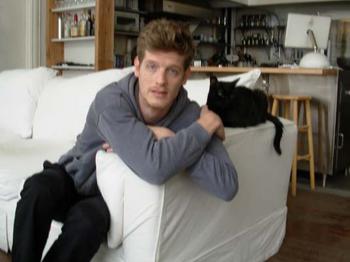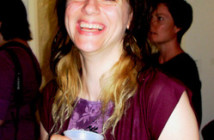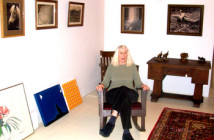The remarkable, panoramic, film inspired paintings of Damian Loeb first came to my attention through the solo exhibition “Public Domain” at Mary Boone Gallery in 2001. This initial exposure was benign as I was unaware of the controversy and venom provoked by his earlier, appropriation based work shown at Deitch Projects from 1998 through 1998. The work I saw was fresh, innovative and galvanic. It combined superb craft, a subtle touch, evocative, subliminal scenes extracted from the establishing shots of important films. Initially, I was not aware that these were appropriated images. Subsequently, I have come to know the extent to which these images were collaged and represent interpretations rather than reproductions of the movie stills. I would learn the importance of film as a trope of memory and template for life experience.
So I missed out on all the bad karma, both critical and personal, that preceded that first exposure to the work which I immediately responded to as challenging and remarkable on every level from aesthetic through philosophical.
To offer a sample of that here is a quote from a Jerry Saltz article “Heat Seekers” that discussed a new generation of emerging painters from February 3-9, 1999. Writing about work on view at Deitch Projects he said, “Damian Loeb's paintings are little more than Photorealism meets '80s photo appropriation. His work, which has the distinction of being simultaneously sensational and dull, is unable to engage you beyond a first moment of pictorial surprise. A bottom feeder, Loeb is attracted to kitsch and violence, combining images scavenged from art, advertising, and the news. The resulting jump-cut narratives are cynical, soulless, and unoriginal. Loeb is an illustrator with a facile hand and a "boy" eye for putting chicks into his environments, especially if the women are naked or dying, or better, both.”
There appeared to be a feeding frenzy among some critics including a Peter Plagens article in Newsweek to which I wrote a response that provided a supportive overview of the group of representational artists including Loeb called ‘The Young and the Restless.” This prompted an e mail note from Damian and I added him as a Maverick subscriber.
In addition to getting trashed by critics he was also sued by photographers whom he had appropriated for those early collage paintings. He later told me that settling all the suits had cost him literally every cent he had made on sales of the early work. He has only recently gotten out of debt which has allowed for starting to paint pictures that please him and have not been preselected by clients or earmarked for gallery exhibitions.
By the time we met, a couple of years ago, through an introduction by legendary Boston dealer, Mario Diacono, there was a dramatic change in his personal life. Early on, the renowned “high school dropout” had been running with his best friend the musician Moby. He was often covered in the NY fashion and gossip columns on the scene with his former fiancé, the editor and writer, Plum Sykes. Last year she published a trashy, best selling book “Bergdorf Blondes” which was a transparently fictionalized account of their breakup.
During trips to the city I have made regular studio visits and gathered a lot of data but still find Damian a fascinating enigma. He has been willing to talk about anything but his work. So I have gathered a great deal of information but been on my own to provide insights. Rather than the much pilloried public persona that preceded me, I encountered a very private, even reclusive individual. He is staying home, rarely ventures out, shuns openings or social events, and works just about round the clock. Damian is married to Zoya, a stunningly beautiful, warm and gracious, Eastern European, fashion model with an Oxford education. On weekends, I have chatted with his teenage daughter, Cameron. And interacted with several cats.
It has been a significant and insightful period to spend with a major artist of his generation (born May 9, 1970 in New Haven). While 30 years of life experience separate us I truly respond to him as a peer. In areas that are vital to him and inform the work he is wise and challenging. I have to be sharp to keep up with him. There has been a steep and enriching learning curve. Through him I have come to view a lot of contemporary art quite differently. Often it has been more comfortable and insightful to discuss film. He is a fanatic on the topic and keeps a megaplex in the basement. At one point we watched, with his running commentary, excerpts of “Close Encounters” from which one of his most important paintings, a view of road kill, is extracted. The scene on which it is based is a blip. But this is precisely what interests him and was the point of departure for the new work which has preoccupied him for the past couple of years and is the subject of a spate of shows in Boston, Cologne, Ridgefield and New York slated for this season. His last NY solo, at Mary Boone with whom he has shown since 1999, was in 2003 and nothing is scheduled right now other than a single painting in a group show in April. Other than the occasional work in a back room at Boone little has been seen or heard of Loeb in New York for the past couple of years.
He could have continued more of the collaged movie stills which were successful in the 2001 and 2003 shows. In fact, he had already prepared a number of collages and during the first studio visit the stretched canvases, which he subsequently gave to other artists, were stacked against the wall. Based on the collages a number of these works were already committed to collectors and galleries. Since one of the works “Halloween” was already sold, he later made the piece. But that was the end of the series. He explained that he could have continued and there was no critical or commercial reason to stop other than the challenge to move on to a new series. There are many reasons for this transition. We have talked a lot around the topic but here it gets slippery.
To summarize that complex dialogue and his refusal to explain the work, or provide straight answers, this is precisely where he always wanted to be at this point in his career. Consider that he never went to art school and has no formal training. So in the early, edgy, provocative Deitch period he created the collages because he needed something to paint. Executing them became his academy and it is how he taught himself. Unfortunately, he had to do this in public and it cost him on many levels. But he reflects that this never bothered him and that he never considered the consequences when he made the work and in hindsight has no regrets. He also refuses to discuss or explain the early work although he has made the images available for me to study. Let’s just say that they represent the juvenilia of a sanguine hotshot who got more than his share of early critical attention.
Part of the plan has been to develop the chops and vision to do original images. Which is where we are right now. For the past couple of years he has shot and downloaded to his computer literally thousands of images which he has constantly culled through and refined. These have been taken on occasions where he has traveled accompanying Zoya on assignment. Or, last summer, when they visited her family in Yugoslavia and London. There are even some Boston shots when he came up for a show at Mario Diacono. The single work he showed with Mario “Cosmopolitan” a very cropped and compressed view of a cocktail party was an endgame comment on his departure from his prior, high profile, social life in which he states that he never felt comfortable. Arguably, my analysis, as a reflection of that, it is telling that the figures are decapitated, dehumanized and signified by a horizontal slash of their designer attire.
Of course, he would express this differently or not at all. He repeatedly states that “If I could explain the work I wouldn’t have to make it.” Last spring, prior to a planned trip to Europe, I asked what he would be shooting? He said that he knew exactly what he wanted to shoot but would never discuss it in advance as that would change and compromise his search for images. Later, viewing the results of these shoots, I would ask him about the location. The answer might be Montenegro, there are a number of these images that have made the final cut into paintings, or London. But I would defy the viewer to find in the image a specific geographic identity. Most of the images, what he refers to as “humanistic landscapes” might have been shot anywhere. A number represent hotel interiors and intimate but identifiable aspects of a woman. Zoya? Sometimes, but not always. Damian declines to elaborate. There is a foreboding, ominous feeling as the woman is layered by shadow or seen as a small distant figure through the grid of a window. Swimming underwater, or floating on a raft, turned away from the viewer. Always what informs the work is that pervasive cinematic quality. That something, an action, is about to happen. Significantly, they all have titles taken from movies.
At times the dialogue gets frustrating. Why won’t he just answer the questions and tell me what the work represents. No luck. I asked him then what he thought of artists who discuss and explain their work? “They are fools,” he said. “Or the work is weak and they are trying to justify it.” He said that, there, I am telling you everything you want to know. Where, I asked? He pointed to the easel and a work in progress. “I give you a ton of information, it’s in the work.” Yes, I agree, and these new works are clearly the best and strongest of his career precisely because they are so embedded.
But I have also come to love the photographs on which they are based. Will he ever show the photographs? He sees them as a means to the paintings. “Because I don’t set them up and shoot them in the field there is a lot of post production work to make them suitable as paintings. A lot of collaging.” So, I responded you continue to be interested in collage as was the case from the Deitch work through the subtle alterations in the movie stills. In “Halloween,” for example, a lot of the detail of the original still was eliminated. Accordingly, the critical perception that he is “copying” and “appropriating” has been terribly wrong. Damian responds that he is not interested in “collage” per se but rather as a means to get the picture right.
Actually, this material and process will be the theme of the Aldrich show “Homecoming” in March. It will be a major show curated by the director, Richard Klein. “They are coming back to select from the large amount of material,” he said. Will there be paintings, I asked? That’s what the Aldrich wants but Damian said that at most there might be just one or two paintings. Actually this is a show that was originally considered for Mary Boone. The exhibition title refers to the fact that, in 1987, as a teenager, Damian worked as a guard at the Aldrich and grew up in the area. “Like Jackson Pollock as a handyman for the Guggenheim,” I suggested, which made him laugh.
Last weekend, while refusing to discuss the specifics of the work, we engaged in a dialogue about the importance of memory to his generation. And how that relates to cinema. “It’s all about memory,” he said. “Like how much memory you have on your hard drive and the ability to store information. Everyone wants a bigger and bigger computer with more and more memory. Eventually we get to be point where we can store every movie we have ever seen, every song we have listened to, every book and magazine we have read, and put our entire life experience and memory into a box.”
He talked about how, early on, he might go to the movies and see a film and now he can own the DVD and play it over and over. That this changes our relationship to works of art particularly what is media driven. We have moved to a quantum level beyond Walter Bengamin’s 1940s essay “The Work of Art in the Age of Mechanical Reproduction.” What was a theory then is a fact for Damian, Moby and their generation. I grew up in a far more primitive age of media so perhaps my perceptions are less rooted in the paradigm of the cinematic. For me the primary reference for life is not a movie. I go back more to Irwin Panofsky and stuff. Real ancient and primitive. More Dylan and Hendrix, Miles and Trane, than Kurt Cobain. Significantly, Dylan, when the topic came up, Damian brushed off as a pretentious twit, too self absorbed in his own genius. It’s here where we have generational clashes.
“The painting is all I am every going to give you,” he said. “I paint what I want something to see and look at. No matter what I say or tell you I will regret. Because it will limit the interpretation of what I painted into the images. It is a long process and a matter of years to develop. Whatever I say today, tomorrow I will say differently. Am I reacting to what people say and criticism? Of course. I trust your ability to say or interpret the reasons for the new work. If there is an overreaching theme of the new work it is the impact of objective memory which is why all of the paintings are named for movies.”
One of the works I found least accessible is “Lolita.” It is by far the most abstracted and appears to be just sunspots and flashes of light. Just how would one relate that image to the famous book and movie by Nabakov? Damian commented that it is one of two paintings that he has “done for myself.” The other is a yet unfinished Hoppersque (a sustaining source) view of a young man looking out a window seen from the street. It is illustrated with this article hanging over his brother Alex’s motorcycle. He explained that “Lolita” is from the “Second Unit Photography Series.” These are the establishing shots of generic images that are worked into the film to create mood and context. It is unique to Loeb’s work by not including a figure. Later we returned to the picture.
The painting, “Reminded me of when Humbert Humbert first saw Lolita,” he said. He compared the difference between what he read in the book and saw in the (first) movie. In the movie he sees Lolita sunbathing. There is no scene in the film that resembles his painting but it is how he feels and interprets that moment in which the man is blinded and overwhelmed by desire for the adolescent girl. So when Damian saw the light streaming and filtered through thick branches of trees overhead it was precisely what he wanted and was conscious of when he made the photograph. Of course, that decisive moment had to be vetted through months of culling and refining from literally thousand of such moments. It had to be compelling enough to make its way to canvas. “The importance of subjective memory is about connections.”
He went on to discuss Jung and the theory of archetypes and our cross references between the conscious and subconscious world. He related this to how a computer cross references data and files. “Our own memory is infinitely crossreferential. It is how we create new experiences and new references. It is all about memory and the craving for ever more memory. It is not surprising that one of the Seven Wonders of the Ancient World was the Library of Alexandria.”
In an era and generation in which all of experience may be reduced to stored data why would one want to make paintings? Too retinal as Duchamp would have it. Here one encounters a different and surprising side of the artist. For one so invested in computers and grabbing data just what is it about the object? He stated that no computer program has succeeded in capturing the touch and surface that only the artist’s hand may create. It’s why he becomes angry discussing contemporary artists whose conceptual paintings are executed by assistants. “There is never an instance in which actually seeing a conceptually based painting improves upon the experience of seeing it in reproduction.”
Bottom line, the hand of the artist is the touch of the poet. Has been and always will be. See for yourself.
Links:
Damien Loeb's website
“Deliverance” is on view from October 7 through November 2, 2005 at Mario Diacono at Ars Libri, 500 Harrison Avenue in Boston.
"Damien Loeb" is on view January 27 to March 7, 2006 at Raphael Jablonka Gallery, Cologne, Germany.
“Homecoming”, curated by Richard Klein, is on view March 26 to August 6, 2006 at The Aldrich Museum of Art, Ridgefield, CT.
All images courtesy of the artist.
- Damien Loeb in the studio.





